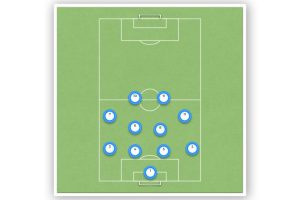Maximizing Defense: Counter-Attacking Soccer Tactics for Slow Teams
As a soccer coach, I understand the importance of having a solid defense. However, sometimes a team’s defenders may not be the fastest or most agile, making it difficult to keep up with opponents on the attack. In these cases, counter-attacking tactics can be a valuable strategy to employ.
Counter-attacking is a style of play that focuses on quickly transitioning from defense to offense, often catching the opposing team off guard. This tactic can be particularly effective for teams with slower defenses, as it allows them to play to their strengths and take advantage of their opponent’s weaknesses.
There are several key components to successful counter-attacking soccer. Firstly, it is important to have a solid defensive foundation, with players who are disciplined and organized. This will allow the team to quickly regain possession of the ball and begin the counter-attack. Additionally, players must be able to quickly and accurately pass the ball up the field, with forwards who are able to make smart runs and finish their chances. By mastering these skills and implementing counter-attacking tactics, a team with a slower defense can still be a formidable opponent on the pitch.
Building a Strong Defense
As a coach, I understand the importance of having a strong defense. When working with a team with a slow defense, it’s crucial to focus on building a strong and organized defense that can withstand pressure and prevent the opposing team from scoring. Here are some tips:
Choosing the Right Formation
Choosing the right formation is essential when building a strong defense. As a coach, I recommend using a formation that suits your team’s strengths and weaknesses. A formation that works well for a team with a slow defense is the 4-4-2 formation. This formation is well-balanced and provides enough cover for the defense. It also allows for quick counter-attacks, which can be effective with a slower defense.
Another important aspect of choosing the right formation is player positioning. It’s important to position players in a way that maximizes their strengths and minimizes their weaknesses. For example, if you have a slow center-back, you can position them deeper in the defense line to reduce the risk of being caught out of position.
Drills for Improving Speed and Agility
Improving speed and agility is crucial when working with a team with a slow defense. Here are some drills that can help:
| Drill | Description |
|---|---|
| Shuttle Runs | Players run back and forth between two cones, touching each cone before returning to the starting position. |
| Ladder Drills | Players run through a ladder placed on the ground, moving their feet quickly and accurately. |
| Cone Drills | Players run around cones placed in a specific pattern, improving their speed and agility. |
It’s important to incorporate these drills into your training sessions regularly to see improvement in speed and agility. Additionally, you can also work on improving overall fitness through cardio exercises like running, cycling, or swimming.
Building a strong defense takes time and effort, but with the right formation and training, it’s possible to create a solid defense even with a slower team. By focusing on player positioning and improving speed and agility through drills, your team can become more organized and effective in preventing the opposing team from scoring.
Counter-Attacking Strategies
If you have a slow defense, counter-attacking can be an effective tactic to use against faster opponents. In this section, I will discuss two sub-sections on how to use counter-attacking strategies effectively.
Exploiting the Opponent’s Weaknesses
One way to effectively counter-attack is to exploit the weaknesses of your opponents. For example, if the opposing team has a weak defense, you can use quick counter-attacks to take advantage of their defensive lapses. Similarly, if the opposing team has a slow midfield, you can use quick transitions to catch them off-guard.
It’s important to identify the weaknesses of your opponents before the game and adjust your strategy accordingly. During the game, you should also be aware of any changes in your opponent’s tactics and adjust your own strategy accordingly.
Effective Use of Long Balls
Another effective counter-attacking strategy is to use long balls to quickly transition from defense to offense. This is especially useful if you have a striker with good speed and aerial ability.
When using long balls, it’s important to make sure that your striker is in a good position to receive the ball. You should also make sure that your midfielders are ready to support the attack and that your defense is ready to cover any counter-attacks from the opposing team.
| Advantages of Long Balls | Disadvantages of Long Balls |
|---|---|
| Quick transition from defense to offense | Low accuracy |
| Can catch opponents off-guard | Relies on individual skill of the striker |
| Can be used to relieve pressure on defense | Can be predictable if overused |
Overall, counter-attacking can be an effective strategy for teams with slow defenses. By exploiting the weaknesses of your opponents and effectively using long balls, you can quickly transition from defense to offense and catch your opponents off-guard.
Teamwork and Communication
As a coach, I understand that teamwork and communication are essential for any successful soccer team. These two elements are particularly important for a team with a slow defense that relies on counter-attacking tactics. In this section, I will discuss the importance of defensive shape and positioning, communication, and coordination for a counter-attacking team.
Defensive Shape and Positioning
When playing a counter-attacking style of soccer, it is crucial to maintain a solid defensive shape and positioning. A slow defense must be well-organized and disciplined to prevent the opposition from exploiting any gaps or spaces. The defenders should be positioned in a way that allows them to quickly transition from defense to attack.
One effective way to maintain a solid defensive shape is to use a zonal marking system. This system allows the defenders to maintain their positions and cover specific areas of the pitch. It also helps the defenders to communicate and coordinate with each other, ensuring that everyone is on the same page.
Communication
Communication is vital for any soccer team, but it is particularly important for a counter-attacking team with a slow defense. The defenders must communicate with each other to ensure that they are in the right position and that they are aware of any potential threats. The midfielders and forwards must also communicate with the defenders to provide cover and support.
One effective way to encourage communication is to assign a leader on the field. This player should be vocal and assertive, providing instructions and guidance to the rest of the team. The leader should also be able to make quick decisions and react to any changes in the game.
Coordination
Coordination is another crucial element of a successful counter-attacking team. The players must be able to work together seamlessly, transitioning from defense to attack quickly and efficiently. The midfielders and forwards must be able to provide support to the defenders, while also making runs and creating scoring opportunities.
One effective way to improve coordination is to practice specific drills and exercises that focus on counter-attacking. These drills should involve the entire team, from the defenders to the forwards. They should also be designed to improve the players’ decision-making skills and their ability to react quickly to changes in the game.
| Point | Description |
|---|---|
| Defensive Shape and Positioning | Use zonal marking system to maintain a solid shape and cover specific areas of the pitch. |
| Communication | Assign a leader on the field and encourage vocal and assertive communication. |
| Coordination | Practice specific drills and exercises that focus on counter-attacking and improve decision-making skills. |
Conclusion
As a coach of a team with a slow defense, I understand the challenges of implementing a counter-attacking strategy. However, I believe that with the right training and tactics, any team can successfully execute counter-attacks.
Firstly, it is important to focus on the transition phase and train players to quickly switch from defense to offense. This can be achieved through drills that simulate match-like situations, such as the 2v1, 3v2, and 4v3 attack drill.
Secondly, it is crucial to have players who are fast and can make forward runs. This can be achieved by identifying players with speed and agility during team selection and training them to make effective runs.
Thirdly, a mid-press defensive strategy can be implemented to create space behind the last line of defense. This can help slow defenders to stay compact and prevent the opposition from scoring.
| Key Takeaways |
|---|
| Focus on transition phase |
| Identify fast players and train them to make forward runs |
| Implement mid-press defensive strategy |
Overall, a counter-attacking strategy can be a great option for teams with slow defenses. By focusing on the transition phase, identifying fast players, and implementing a mid-press defensive strategy, any team can successfully execute counter-attacks and score goals.






